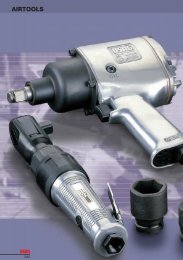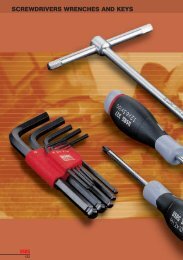Industrial seal self study guide - SKF.com
Industrial seal self study guide - SKF.com
Industrial seal self study guide - SKF.com
You also want an ePaper? Increase the reach of your titles
YUMPU automatically turns print PDFs into web optimized ePapers that Google loves.
Installation (cont.)<br />
For best results, the center of the tool should be open so pressure is<br />
applied only at the outer edge.<br />
The tools used to install <strong>seal</strong>s can often affect <strong>seal</strong> performance.<br />
For instance, a screwdriver may easily cut the <strong>seal</strong> lip, but make<br />
the damage invisible to the eye. Even blunt-end drifts can damage<br />
the <strong>seal</strong> case or distort the <strong>seal</strong> from its proper working position.<br />
68<br />
The arbor press installation method<br />
provides the uniform pressure needed<br />
to over<strong>com</strong>e <strong>seal</strong> .D. press fit (fig. 8b).<br />
When using the wooden block<br />
installation method, apply force<br />
in the area over the center of<br />
the <strong>seal</strong> (fig. 8c).<br />
Ideal Installation Conditions—Arbor Press<br />
This hydraulic press method is best for providing the uniform pressure<br />
necessary to over<strong>com</strong>e <strong>seal</strong> O.D. press fit, usually 0.004 to 0.008<br />
inches (0. 102mm to 0.203mm) larger than the bore (fig. 8b).<br />
Before installation, pre-lube the <strong>seal</strong>. To protect the <strong>seal</strong> outer shell,<br />
apply pressure through an installation collar that contacts the <strong>seal</strong> near<br />
the O.D. and has a relieved center to avoid pressure on the I.D. of the<br />
<strong>seal</strong> face.<br />
When installing the <strong>seal</strong> in a step bore, be careful not to squeeze or<br />
crush the <strong>seal</strong> case. When installing in a “through” bore, apply pressure<br />
through a steel plate or plug larger than bore diameter (to set the <strong>seal</strong><br />
perpendicular to the shaft).<br />
Alternative Installation<br />
Method—Wooden Block Installation<br />
Use of a wooden block as an installation tool is acceptable when the<br />
<strong>seal</strong> is to be installed flush with a housing and no arbor press is available.<br />
Before installation, pre-lube the <strong>seal</strong>. Use the flat surface of the woodblock<br />
to press the <strong>seal</strong> in place. A steel hammer can be used to apply<br />
force to the wood block and to over<strong>com</strong>e the <strong>seal</strong>’s press fit diameter.<br />
Apply force evenly across the back of the <strong>seal</strong>. That is, avoid forcing<br />
one side of the <strong>seal</strong> first, thus cocking the <strong>seal</strong> (fig. 8c). Apply no direct<br />
force to the <strong>seal</strong> I.D.<br />
Whatever tool is used, remember that seating force must be applied<br />
and spread out around the entire circumference of the <strong>seal</strong>. A direct<br />
blow on one side of the <strong>seal</strong> distorts the shell and can cause the lip<br />
to be pressed against the shaft. This action produces increased<br />
friction between the lip and the shaft surface.<br />
If installation pressure is applied to the <strong>seal</strong>’s inside diameter, the shell<br />
is forced upward, lifting the lip from the shaft surface. If the <strong>seal</strong> is<br />
cocked—not perpendicular to the shaft and bore—the result will be<br />
too much contact on one side, and not enough on the other.<br />
Careless installation is one of the most <strong>com</strong>mon reasons for <strong>seal</strong><br />
problems. The end-user can prevent these problems by reviewing<br />
and following the re<strong>com</strong>mendations on the opposite page.







